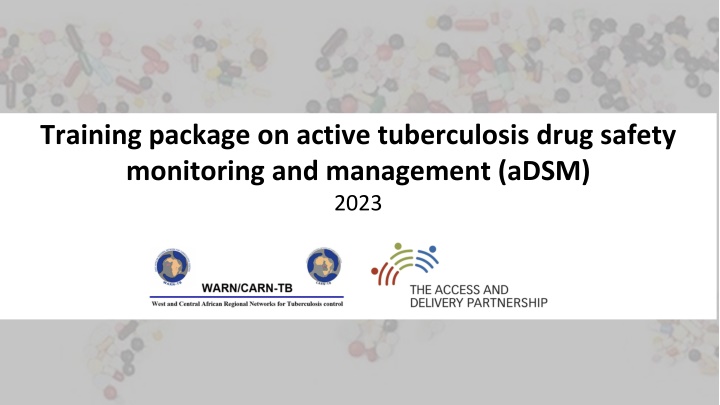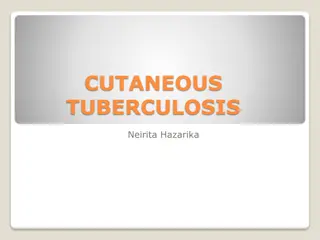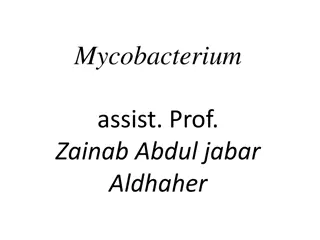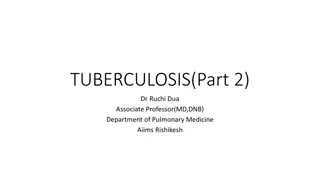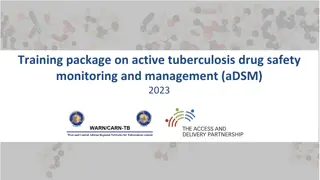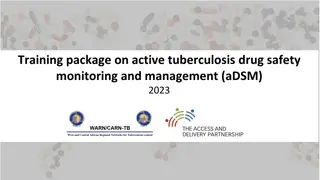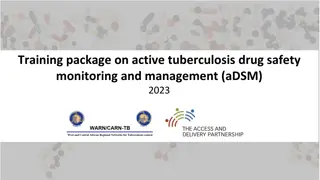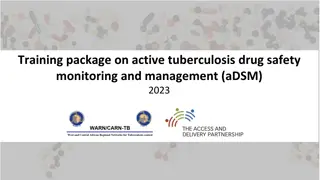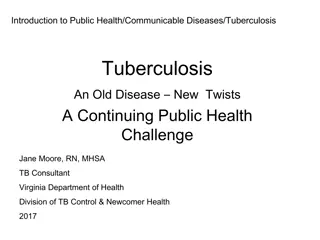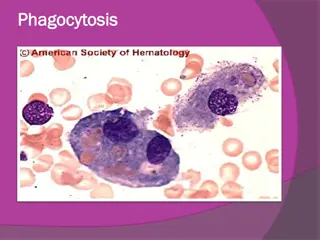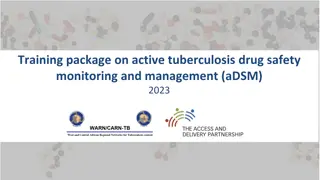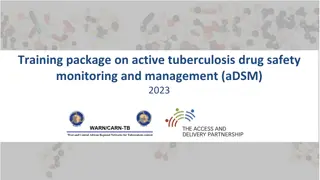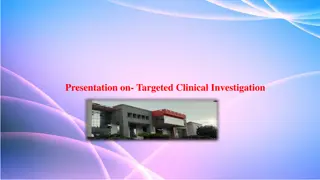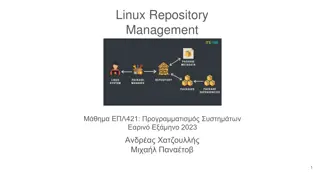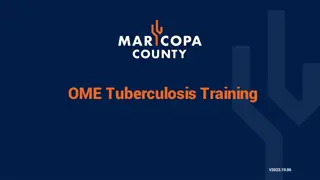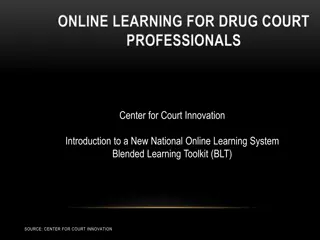Active Tuberculosis Drug Safety Monitoring and Management Training Package 2023
This training package focuses on the safety monitoring and management of active tuberculosis drugs, specifically emphasizing causality assessment in determining adverse reactions. Participants will learn about assessing the likelihood of TB medicines causing adverse events, attributing relationships between events and exposures, and distinguishing between adverse drug reactions and adverse events. The course provides essential knowledge for healthcare professionals involved in TB treatment and management.
Download Presentation

Please find below an Image/Link to download the presentation.
The content on the website is provided AS IS for your information and personal use only. It may not be sold, licensed, or shared on other websites without obtaining consent from the author.If you encounter any issues during the download, it is possible that the publisher has removed the file from their server.
You are allowed to download the files provided on this website for personal or commercial use, subject to the condition that they are used lawfully. All files are the property of their respective owners.
The content on the website is provided AS IS for your information and personal use only. It may not be sold, licensed, or shared on other websites without obtaining consent from the author.
E N D
Presentation Transcript
Training package on active tuberculosis drug safety monitoring and management (aDSM) 2023
3.2. Causality assessment: scales and methods
Learning objectives By the end of this presentation, the participant is expected to be able to: 1. Describe the main principles of causality assessment 2. Identify the different levels of certainty when attributing an event to a suspected exposure
Causality assessment (1) An integral part of clinical management Evaluating the likelihood that a TB medicine was the causative agent of an observed adverse reaction forms part of clinical evaluation. While the details of the systematic method of conducting causality assessment may not be familiar to the practitioner, the overall approach is not too different from the clinical practice followed when evaluating any patient on treatment.
Causality assessment (2) The attribution (relationship or causality or drug related assessment) must be made A physician or any other health care professional who has the right expertise describes the relationship between the adverse event and an exposure This determination must be recorded both in the medical record as well as in the case report form For aDSM, causality assessment should be made primarily at the country level and by consulting the relevant data sources close to where the event occurred
Causality assessment (3) 1) Is there a convincing relationship between the medicine and the event ? 2) Did the medicine actually cause the event ? OR Other TB medicines ? Medicines for other diseases ? Effect of the TB disease itself or co-morbidities?
Causality assessment (4) reaction versus event Adverse drug reactions (ADR): a response to a medicine which is noxious and unintended, and which occurs at doses normally used in humans Adverse events (AE): Any untoward medical occurrence that may present during treatment with a pharmaceutical product, but which does not necessarily have a causal relationship with this treatment
Causality assessment (5) main things to look out for Is the time to onset of the event compatible with the suspected cause (plausible time-frame) ? Did the event occur after the start of some other medicine or new illness? Is the event plausible given what is known about the drug? Is there any other possible cause for the event? What is the response to withdrawal of the medicine (dechallenge)? What is the response to rechallenge, if applicable?
Key data elements for causality assessment Medical history (incl. concomitant disease) Other risk factors (social factors, alcohol use, substance abuse, etc.) Details of drugs taken : names, doses, routes Start and stop dates and indications for use Description of adverse event, including clinical description, laboratory results, and date of onset / end Evolution of event, severity, seriousness, outcome
Classification of level of relationship Time to event plausible? Other explanation excluded? Recovery after withdrawal? Recurrence after rechallenge? notes Level Rechallenge not needed in case of an anaphylactic reaction Yes Yes Yes Yes Definite / certain Yes Yes Yes No or ? Probable Yes No or ? ? No or ? Possible Suggestive if event resolves despite continued exposure No No or ? No No or ? Unlikely No No No No Not related Insufficient information about the ADRs to allow for an assessment of causality Unclassifiable
Inference on the grade of the relationship Category Definite / certain Definition There is clear evidence to suggest a causal relationship and other possible contributing factors can be ruled out. Probable There is evidence to suggest a likely causal relationship and the influence of other factors is unlikely. Possible There is some evidence to suggest a causal relationship (e.g. because the event occurs within a reasonable time after administration of the trial medication). However, the influence of other factors may have contributed to the event (e.g. the patient s clinical condition, other concomitant treatments). Unlikely There is little evidence to suggest there is a causal relationship (e.g. the event did not occur within a reasonable time after administration of the study regimen). There is another reasonable explanation for the event (e.g. the patient s clinical condition, other concomitant treatment). Not related There is no evidence of any causal relationship . Unclassifiable There is insufficient information about the ADRs to allow for an assessment of causality.
Naranjo ADR probability scale (items and score) Source: Naranjo CA et al. A method for estimating the probability of adverse drug reactions. Clin Pharmacol Ther 1981; 30: 239 - 245.
WHO-UMC system Practical tool for the assessment of case reports Combined assessment taking into account clinical-pharmacological aspects of the case history the quality of the documentation Other criteria such as previous knowledge and statistical chance play a less prominent role as to facilitate detection of unknown and unexpected adverse drug reactions Source: http://who-umc.org/Graphics/24734.pdf
Approaches to test hypotheses Method Principles + / - Reproducibility Expert opinion Based on judgment of individual experts Subjective Low Algorithms Follows a decision tree defined by experts / pharmacology More standardized than expert opinion Low (subjective) Probability assessment Bayesian approach Need special skills; numeric data Considered gold standard Adapted from R Benkirane (WHO-CC Morocco; 2014)
Who does the causality assessment? National TB programme Pharmaconvigilance programme Drug safety monitoring (aDSM Component) Further analysis for signal detection/causality assessment and communication TB-MR treatment facility Cohort-based follow-up of patients with questionnaires to elicit symptoms; and routine tests for TB drug safety monitoring Delivery of treatment Management of adverse reactions Reporting as required by local regulations Recording of all SAEs in a national aDSM database (regularly transferred into the global database) Signal detection/causality assessment by the NTP (if capacity is limited by national pharmacovigilance system (NPV)) Support for signal detection and causality assessment Inform updates of country and global drug safety profile Inform update of treatment policy and patient care practice (as per PMDT guidance) New evidence
Conclusions An attempt to attribute an event to a cause is a basic principle of monitoring and clinical management in aDSM Attributing a relationship requires a systematic process and is one of the main reasons why data are collected in aDSM. The exercise is done by experts who are competent in therapeutics and toxicity The causality assessment once done attributes a level of certainty between the event and the exposure, ranging from certain to unclassifiable
Acknowledgements The development of the aDSM training material was funded by TDR as part of the Access and Delivery Partnership (ADP) with funding from the Government of Japan. These training materials were put together in 2016 the WHO Task Force on aDSM with technical partners KNCV Tuberculosis Foundation, Management Sciences for Health (SIAPS), MSF, WHO GTB, and TDR. The materials were updated in 2022-23 by Mahamadou Bassirou Souleymane (TDR consultant) with Marie-Eve Raguenaud (TDR), Branwen J Hennig (TDR), and Corinne Merle (TDR), and reviewed by Linh Nhat Nguyen (WHO/GTB), Medea Gegia (WHO/GTB), and Fuad Mirzayev (WHO/GTB). We thank all members of the WARN/CARN-TB working group on aDSM who contributed to the development of the aDSM generic guidelines as well as the secretariat, particularly Dr Christ Houessinon: Disadidi Ambrioso, Esse Marius, Adomou Jamal Rouamba Ruffine, Haro Sougrimani, Koumbem Boureima, Nsanzerugeze Jos lyne, Tollo Tollo Daniel Alphonse D sir , Mpaba Minkat Th ophile Mistral, Julie Abessolo, Ursule IDOKO, Tijan Baldeh , Wandifa Samateh, Tida S Kinteh, Alieu Wurie, Mardemn Yeasuen, Benjamin K. Quenneh, Cheick Oumar Bah, Kane El Hadj Malick, Aw Idriss, Mamoudou Hama Rachida, Gagara I. M. Assiatou, Katamb Balkissa, Seiyabatou ElhSaidou, Liombo Anastasie, Lunganyu Junior, Kitambala Sentime, Lula Yves , Habimana-Mucyo Yves, Migambi Patrick, dos Santos Brigite, Castro V nia, Wadson Cruz, Gueye Aminata, Mukeh Fahnbulleh, Bailor Samuel, Manjo Lamin, Saleh Mahareb Abdoulaye, Haroun Saleh Naima, Mouhoudine Yerima, Kpelafia Silifa
